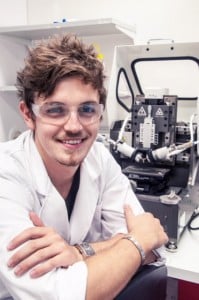 A recent post by Ari Armstrong about the wonders of 3D printing applied to the field of medicine concluded, “What’s next we can only imagine.” Now, just a few weeks later, we have an indication. Researchers are on course to print functional, customized human tissues and organs.
A recent post by Ari Armstrong about the wonders of 3D printing applied to the field of medicine concluded, “What’s next we can only imagine.” Now, just a few weeks later, we have an indication. Researchers are on course to print functional, customized human tissues and organs.
On May 3, researchers from the University of Wollongong (Australia) announced that they are likely only a few years away from printing custom body parts and about a decade away from printing organs. Gordon Wallace, director of the University of Wollongong’s ARC Centre of Excellence for Electromaterials Science, stated:
Within a few years, we believe it will be possible to manufacture living tissues like skin, cartilage, arteries and heart valves using cells and biomaterials. Using a patient’s own cells to create this tissue avoids issues of immune rejection. By 2025, it is feasible that we will be able to fabricate complete functional organs, tailored for an individual patient.
On another front, Organovo, a medical company specializing in 3D printing, has successfully printed liver tissue that reacts to certain treatments in the same way real liver tissue does. Researchers at Organovo believe such tissue can be used to test new drugs and thus reduce the time required for the drug testing process. And, although Organovo has made great strides in research and drug testing, its larger goal is to build human tissues for transplantation.
 These recent announcements follow news from the University of Pennsylvania, where researchers developed a new way to build circulatory systems to feed lab-created tissues. Using RepRap, a relatively inexpensive 3D printer, these researchers created a sugar-based lattice mold. Once living cells grew around the mold, researchers dissolved the sugar and used the resulting network of vessels to infuse the tissue with nutritive fluid. This research could pave the way for providing blood flow to manufactured organs.
These recent announcements follow news from the University of Pennsylvania, where researchers developed a new way to build circulatory systems to feed lab-created tissues. Using RepRap, a relatively inexpensive 3D printer, these researchers created a sugar-based lattice mold. Once living cells grew around the mold, researchers dissolved the sugar and used the resulting network of vessels to infuse the tissue with nutritive fluid. This research could pave the way for providing blood flow to manufactured organs.
With the help of 3D printing technology, scientists, engineers, and businessmen are quickly advancing the field of medicine and options in transplants. Expect to see customized printed tissues and organs in the not-too-distant future—offering hope and life to those awaiting transplants.
Cheers to the men and women of science!
Like this post? Join our mailing list to receive our weekly digest. And for in-depth commentary from an Objectivist perspective, subscribe to our quarterly journal, The Objective Standard.
Related:
- Walt Disney’s EPCOT: The City of Tomorrow that Might Have Been
- The Burgeoning Micro-Production Revolution
Image: University of Wollongong











